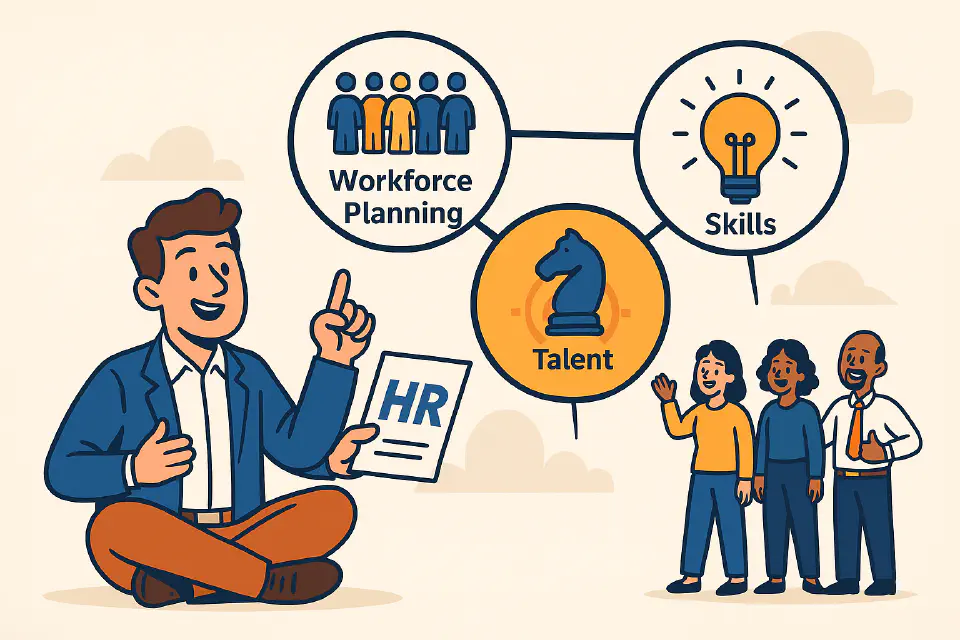
HR as a Workforce Shaper
Workforces don't just happen — they're built. This page explores how HR shapes the workforce through strategic planning, labor market insights, internal mobility, and proactive design of future capability needs.
Why Workforce Shaping Is a Core HR Responsibility
Business goals change. Markets shift. Technology advances. Yet in many companies, workforce structures remain reactive, legacy-bound, or disconnected from strategy.
HR as a workforce shaper takes a proactive role:
- Aligning workforce composition with business strategy
- Anticipating future skill needs
- Designing flexible, resilient talent models
This role is not about filling vacancies. It’s about building a system where the right capabilities are available — at the right time, place, and cost.
Strategic Foundations: How HR Shapes the Workforce
Workforce shaping goes beyond forecasting headcount. It’s about designing the right mix of roles, skills, formats, and sources to deliver outcomes — now and in the future.
Workforce Segmentation
HR must move past generic categories like “white-collar” and “blue-collar.” Instead, segment by:
- Business-critical vs. support roles
- Customer-facing vs. back-office
- High-scarcity skills vs. easily reskilled
- Core employees vs. flexible workforce (freelancers, vendors, gig)
This segmentation allows differentiated investment, development, and retention strategies.
Strategic Workforce Planning (SWP)
SWP is the structured process of:
- Understanding current workforce supply
- Forecasting future demand
- Identifying gaps (quantity and capability)
- Designing interventions (buy, build, borrow, automate)
Done well, it connects business planning, finance, and HR into one aligned picture.
Skills-Based Organization (SBO)
The shift from job titles to skills is core to modern workforce shaping:
- Identify skills that drive competitive advantage
- Map skill adjacencies and pathways
- Use skills to guide hiring, mobility, development, and workforce design
This approach makes organizations more agile — and helps unlock internal mobility.
Designing for Flexibility: Hybrid and Distributed Workforces
HR must shape workforce models that support:
- In-office, hybrid, and remote work
- Project-based teaming and cross-functional squads
- Global, asynchronous collaboration
This involves not just policies, but technology, manager training, and trust systems.
Using External Talent Strategically
Freelancers, contractors, vendors, and partners are part of the modern workforce.
HR’s role is to:
- Define what work is core vs. externalizable
- Manage risk, quality, and compliance
- Integrate external talent into culture and performance systems
Key Tools and Models for Workforce Shaping
| Tool or Method | Purpose |
|---|---|
| SWP Scenario Planning | Test how demand shifts under different assumptions |
| Heatmaps & Risk Matrices | Visualize shortages, surpluses, or workforce vulnerabilities |
| Talent Flow Mapping | Track how people move in, through, and out of the organization |
| External Labor Analytics | Understand market supply, rates, and availability |
| Skills Taxonomy | Standardize language across job families and development paths |
Case Studies: Workforce Shaping in Action
Case 1: Transitioning to Skills-Based Planning
A financial services firm faced increasing automation in operations roles. Rather than issuing mass layoffs, HR:
- Mapped skills across impacted employees
- Partnered with L&D to offer reskilling into client support and analytics roles
- Used external market data to guide sourcing for gaps
Result: 68% internal redeployment rate, $2.1M saved in separation costs.
Case 2: Managing Workforce in Expansion Markets
A global software firm expanded into Southeast Asia. HR shaped the workforce by:
- Partnering with local universities for pipeline development
- Introducing a project-based contractor pool to manage uncertain demand
- Building dual-language onboarding for distributed teams
Result: Time-to-productivity for new hires dropped by 25%.
Case 3: Navigating Decline in Legacy Products
An industrial company began phasing out a hardware product line. HR used strategic workforce planning to:
- Forecast declining skill needs 2 years ahead
- Create exit + redeployment tracks with managers
- Offer incentives for early transitions to emerging business units
Result: Avoided involuntary layoffs, improved internal mobility perception.
Common Challenges in Workforce Shaping
Lack of Alignment Across Stakeholders
- Challenge: HR, Finance, and Business Planning work in silos
- Solution: Establish a cross-functional SWP council; co-own workforce forecasts
Poor Data Quality or Accessibility
- Challenge: Decisions are made on outdated or siloed workforce data
- Solution: Invest in clean, integrated people analytics and external benchmarks
Short-Termism in Business Strategy
- Challenge: Business leaders prioritize next quarter over next 3 years
- Solution: Use scenario planning to make long-term risks more tangible
Cultural Resistance to Flex Models
- Challenge: Leaders distrust non-traditional work arrangements
- Solution: Pilot hybrid/workforce experiments, measure outcomes, and publish stories
Capabilities HR Needs to Shape the Workforce
| Capability | Why It Matters |
|---|---|
| Labor Market Intelligence | Anticipates availability, cost, and volatility of talent supply |
| Scenario Modeling | Supports evidence-based business case building |
| Systems Thinking | Connects workforce data with org design and strategy |
| Change Navigation | Helps embed new structures, contracts, models in practice |
| Stakeholder Influence | Secures buy-in from execs, finance, and line leaders |
Maturity Model: Workforce Shaping
| Stage | Characteristics |
|---|---|
| Reactive | Hiring decisions are tactical, gaps filled ad hoc |
| Forecasting | Workforce plans are based on simple supply/demand models |
| Integrated | HR, Finance, and Business co-create dynamic, skills-focused plans |
| Strategic | Workforce shaping is embedded in transformation and business model evolution |
Best Practice: Shape Through Dialogue, Not Just Data
Final Thought
Shaping the workforce isn’t an HR initiative. It’s a business necessity — and HR is uniquely positioned to lead it.
By blending data, design, and dialogue, HR can ensure organizations aren’t just staffed — they’re ready. Ready for growth. Ready for disruption. Ready for what’s next.
Because a well-shaped workforce doesn’t just fill roles — it unlocks possibility.